Effects of Whey Protein Supplementation on Body Composition, Muscular Strength, and Cardiometabolic Health in Older Adults: A Systematic Review with Pairwise Meta-Analysis
Abstract
1. Introduction
2. Materials and Methods
2.1. Search Strategy
2.2. Study Selection and Eligibility Criteria
2.3. Data Extraction and Synthesis
2.4. Quality Assessment
2.5. Statistical Analysis
3. Results
3.1. Search Strategy
3.2. Literature Characteristics and Quality Assessment
3.3. Meta-Analysis
3.3.1. Body Composition
3.3.2. Glycemic Markers
3.3.3. Lipid Profiles
3.3.4. Muscular Strength
3.3.5. Subgroup Analyses
4. Discussion
5. Conclusions
Supplementary Materials
Author Contributions
Funding
Institutional Review Board Statement
Informed Consent Statement
Data Availability Statement
Conflicts of Interest
Abbreviations
| PRISMA | Preferred Reporting Items for Systematic Reviews and Meta-Analyses |
| PROSPERO | International Prospective Register of Systematic Reviews |
| PICOS | Population, Intervention, Comparator, Outcomes, Study design |
| WP | Whey Protein |
| PLA | Placebo |
| BF% | Body Fat Percentage |
| LBM | Lean Body Mass |
| WC | Waist Circumference |
| WHR | Waist-to-Hip Ratio |
| HOMA-IR | Homeostatic Model Assessment for Insulin Resistance |
| TG | Triglycerides |
| TCH | Total Cholesterol |
| LDL | Low-Density Lipoprotein Cholesterol |
| HDL | High-Density Lipoprotein Cholesterol |
| IQR | Interquartile Range |
| SD | Standard Deviation |
| PEDro | Physiotherapy Evidence Database |
| CMA3 | Comprehensive Meta-Analysis version 3 |
| WMD | Weighted Mean Difference |
| SMD | Standardized Mean Difference |
| CI | Confidence Interval |
| RCT | Randomized Controlled Trial |
References
- Beard, J.R.; Officer, A.; De Carvalho, I.A.; Sadana, R.; Pot, A.M.; Michel, J.-P.; Lloyd-Sherlock, P.; Epping-Jordan, J.E.; Peeters, G.G.; Mahanani, W.R. The World report on ageing and health: A policy framework for healthy ageing. Lancet 2016, 387, 2145–2154. [Google Scholar] [CrossRef]
- Grevendonk, L.; Connell, N.J.; McCrum, C.; Fealy, C.E.; Bilet, L.; Bruls, Y.M.; Mevenkamp, J.; Schrauwen-Hinderling, V.B.; Jörgensen, J.A.; Moonen-Kornips, E. Impact of aging and exercise on skeletal muscle mitochondrial capacity, energy metabolism, and physical function. Nat. Commun. 2021, 12, 4773. [Google Scholar] [CrossRef]
- Kim, T.N.; Choi, K.M. The implications of sarcopenia and sarcopenic obesity on cardiometabolic disease. J. Cell. Biochem. 2015, 116, 1171–1178. [Google Scholar] [CrossRef]
- Ponti, F.; Santoro, A.; Mercatelli, D.; Gasperini, C.; Conte, M.; Martucci, M.; Sangiorgi, L.; Franceschi, C.; Bazzocchi, A. Aging and imaging assessment of body composition: From fat to facts. Front. Endocrinol. 2020, 10, 861. [Google Scholar] [CrossRef]
- Beaufrere, B.; Morio, B. Fat and protein redistribution with aging: Metabolic considerations. Eur. J. Clin. Nutr. 2000, 54, S48–S53. [Google Scholar] [CrossRef] [PubMed]
- Kuk, J.L.; Saunders, T.J.; Davidson, L.E.; Ross, R. Age-related changes in total and regional fat distribution. Ageing Res. Rev. 2009, 8, 339–348. [Google Scholar] [CrossRef] [PubMed]
- Lind, L.; Sundström, J.; Ärnlöv, J.; Lampa, E. Impact of aging on the strength of cardiovascular risk factors: A longitudinal study over 40 years. J. Am. Heart Assoc. 2018, 7, e007061. [Google Scholar] [CrossRef] [PubMed]
- Pimenta, E.; Oparil, S. Management of hypertension in the elderly. Nat. Rev. Cardiol. 2012, 9, 286–296. [Google Scholar] [CrossRef]
- Liu, H.-H.; Li, J.-J. Aging and dyslipidemia: A review of potential mechanisms. Ageing Res. Rev. 2015, 19, 43–52. [Google Scholar] [CrossRef]
- Gobal, F.A.; Mehta, J.L. Management of dyslipidemia in the elderly population. Ther. Adv. Cardiovasc. Dis. 2010, 4, 375–383. [Google Scholar] [CrossRef]
- Scheen, A. Diabetes mellitus in the elderly: Insulin resistance and/or impaired insulin secretion? Diabetes Metab. 2005, 31, 5S27–25S34. [Google Scholar] [CrossRef]
- Chang, A.M.; Halter, J.B. Aging and insulin secretion. Am. J. Physiol.-Endocrinol. Metab. 2003, 284, E7–E12. [Google Scholar] [CrossRef]
- Chung, H.Y.; Cesari, M.; Anton, S.; Marzetti, E.; Giovannini, S.; Seo, A.Y.; Carter, C.; Yu, B.P.; Leeuwenburgh, C. Molecular inflammation: Underpinnings of aging and age-related diseases. Ageing Res. Rev. 2009, 8, 18–30. [Google Scholar] [CrossRef]
- Wilkinson, D.J.; Piasecki, M.; Atherton, P. The age-related loss of skeletal muscle mass and function: Measurement and physiology of muscle fibre atrophy and muscle fibre loss in humans. Ageing Res. Rev. 2018, 47, 123–132. [Google Scholar] [CrossRef]
- Deutz, N.E.; Bauer, J.M.; Barazzoni, R.; Biolo, G.; Boirie, Y.; Bosy-Westphal, A.; Cederholm, T.; Cruz-Jentoft, A.; Krznaric, Z.; Nair, K.S.; et al. Protein intake and exercise for optimal muscle function with aging: Recommendations from the ESPEN Expert Group. Clin. Nutr. 2014, 33, 929–936. [Google Scholar] [CrossRef]
- Nowson, C.; O’Connell, S. Protein Requirements and Recommendations for Older People: A Review. Nutrients 2015, 7, 6874–6899. [Google Scholar] [CrossRef]
- Camargo, L.D.R.; Doneda, D.; Oliveira, V.R. Whey protein ingestion in elderly diet and the association with physical, performance and clinical outcomes. Exp. Gerontol. 2020, 137, 110936. [Google Scholar] [CrossRef] [PubMed]
- Shimazaki, Y.; Saito, M.; Nonoyama, T.; Tadokoro, Y. Oral factors associated with swallowing function in independent elders. Oral Health Prev. Dent. 2020, 18, a45071. [Google Scholar] [PubMed]
- Campbell, W.W.; Johnson, C.A.; McCabe, G.P.; Carnell, N.S. Dietary protein requirements of younger and older adults. Am. J. Clin. Nutr. 2008, 88, 1322–1329. [Google Scholar] [CrossRef]
- Bauer, J.; Biolo, G.; Cederholm, T.; Cesari, M.; Cruz-Jentoft, A.J.; Morley, J.E.; Phillips, S.; Sieber, C.; Stehle, P.; Teta, D.; et al. Evidence-based recommendations for optimal dietary protein intake in older people: A position paper from the PROT-AGE Study Group. J. Am. Med. Dir. Assoc. 2013, 14, 542–559. [Google Scholar] [CrossRef] [PubMed]
- Houston, D.K.; Nicklas, B.J.; Ding, J.; Harris, T.B.; Tylavsky, F.A.; Newman, A.B.; Lee, J.S.; Sahyoun, N.R.; Visser, M.; Kritchevsky, S.B. Dietary protein intake is associated with lean mass change in older, community-dwelling adults: The Health, Aging, and Body Composition (Health ABC) Study. Am. J. Clin. Nutr. 2008, 87, 150–155. [Google Scholar] [CrossRef]
- Bergia III, R.E.; Hudson, J.L.; Campbell, W.W. Effect of whey protein supplementation on body composition changes in women: A systematic review and meta-analysis. Nutr. Rev. 2018, 76, 539–551. [Google Scholar] [CrossRef]
- Finger, D.; Goltz, F.R.; Umpierre, D.; Meyer, E.; Rosa, L.H.T.; Schneider, C.D. Effects of protein supplementation in older adults undergoing resistance training: A systematic review and meta-analysis. Sports Med. 2015, 45, 245–255. [Google Scholar] [CrossRef]
- Pasiakos, S.M.; McLellan, T.M.; Lieberman, H.R. The effects of protein supplements on muscle mass, strength, and aerobic and anaerobic power in healthy adults: A systematic review. Sports Med. 2015, 45, 111–131. [Google Scholar] [CrossRef] [PubMed]
- Ten Haaf, D.S.; Nuijten, M.A.; Maessen, M.F.; Horstman, A.M.; Eijsvogels, T.M.; Hopman, M.T. Effects of protein supplementation on lean body mass, muscle strength, and physical performance in nonfrail community-dwelling older adults: A systematic review and meta-analysis. Am. J. Clin. Nutr. 2018, 108, 1043–1059. [Google Scholar] [CrossRef]
- Mangano, K.M.; Sahni, S.; Kiel, D.P.; Tucker, K.L.; Dufour, A.B.; Hannan, M.T. Dietary protein is associated with musculoskeletal health independently of dietary pattern: The Framingham Third Generation Study. Am. J. Clin. Nutr. 2017, 105, 714–722. [Google Scholar] [CrossRef] [PubMed]
- Adams, R.L.; Broughton, K.S. Insulinotropic effects of whey: Mechanisms of action, recent clinical trials, and clinical applications. Ann. Nutr. Metab. 2016, 69, 56–63. [Google Scholar] [CrossRef] [PubMed]
- Pal, S.; Radavelli-Bagatini, S. The effects of whey protein on cardiometabolic risk factors. Obes. Rev. 2013, 14, 324–343. [Google Scholar] [CrossRef]
- Rondanelli, M.; Klersy, C.; Terracol, G.; Talluri, J.; Maugeri, R.; Guido, D.; Faliva, M.A.; Solerte, B.S.; Fioravanti, M.; Lukaski, H. Whey protein, amino acids, and vitamin D supplementation with physical activity increases fat-free mass and strength, functionality, and quality of life and decreases inflammation in sarcopenic elderly. Am. J. Clin. Nutr. 2016, 103, 830–840. [Google Scholar] [CrossRef]
- Oikawa, S.Y.; Kamal, M.J.; Webb, E.K.; McGlory, C.; Baker, S.K.; Phillips, S.M. Whey protein but not collagen peptides stimulate acute and longer-term muscle protein synthesis with and without resistance exercise in healthy older women: A randomized controlled trial. Am. J. Clin. Nutr. 2020, 111, 708–718. [Google Scholar] [CrossRef]
- Al-Rawhani, A.H.; Adznam, S.N.A.; Zaid, Z.A.; Yusop, N.B.M.; Sallehuddin, H.M.; Alshawsh, M.A. Effectiveness of whey protein supplementation on muscle strength and physical performance of older adults: A systematic review and meta-analysis of randomized clinical trials. Clin. Nutr. 2024, 43, 2412–2426. [Google Scholar] [CrossRef]
- Cuyul-Vasquez, I.; Pezo-Navarrete, J.; Vargas-Arriagada, C.; Ortega-Díaz, C.; Sepulveda-Loyola, W.; Hirabara, S.M.; Marzuca-Nassr, G.N. Effectiveness of whey protein supplementation during resistance exercise training on skeletal muscle mass and strength in older people with sarcopenia: A systematic review and meta-analysis. Nutrients 2023, 15, 3424. [Google Scholar] [CrossRef]
- Liao, C.-D.; Chen, H.-C.; Huang, S.-W.; Liou, T.-H. The role of muscle mass gain following protein supplementation plus exercise therapy in older adults with sarcopenia and frailty risks: A systematic review and meta-regression analysis of randomized trials. Nutrients 2019, 11, 1713. [Google Scholar] [CrossRef]
- Li, M.-L.; Zhang, F.; Luo, H.-Y.; Quan, Z.-W.; Wang, Y.-F.; Huang, L.-T.; Wang, J.-H. Improving sarcopenia in older adults: A systematic review and meta-analysis of randomized controlled trials of whey protein supplementation with or without resistance training. J. Nutr. Health Aging 2024, 28, 100184. [Google Scholar] [CrossRef]
- Pal, S.; Ellis, V. The chronic effects of whey proteins on blood pressure, vascular function, and inflammatory markers in overweight individuals. Obesity 2010, 18, 1354–1359. [Google Scholar] [CrossRef]
- Kirk, B.; Mooney, K.; Vogrin, S.; Jackson, M.; Duque, G.; Khaiyat, O.; Amirabdollahian, F. Leucine-enriched whey protein supplementation, resistance-based exercise, and cardiometabolic health in older adults: A randomized controlled trial. J. Cachexia Sarcopenia Muscle 2021, 12, 2022–2033. [Google Scholar] [CrossRef] [PubMed]
- Chiang, S.-W.; Liu, H.-W.; Loh, E.-W.; Tam, K.-W.; Wang, J.-Y.; Huang, W.-L.; Kuan, Y.-C. Whey protein supplementation improves postprandial glycemia in persons with type 2 diabetes mellitus: A systematic review and meta-analysis of randomized controlled trials. Nutr. Res. 2022, 104, 44–54. [Google Scholar] [CrossRef] [PubMed]
- Prokopidis, K.; Mazidi, M.; Sankaranarayanan, R.; Tajik, B.; McArdle, A.; Isanejad, M. Effects of whey and soy protein supplementation on inflammatory cytokines in older adults: A systematic review and meta-analysis. Br. J. Nutr. 2023, 129, 759–770. [Google Scholar] [CrossRef]
- Vajdi, M.; Musazadeh, V.; Zareei, M.; Adeli, S.; Karimi, A.; Hojjati, A.; Darzi, M.; Shoorei, H.; Farhangi, M.A. The effects of whey protein on blood pressure: A systematic review and dose-response meta-analysis of randomized controlled trials. Nutr. Metab. Cardiovasc. Dis. 2023, 33, 1633–1646. [Google Scholar] [CrossRef] [PubMed]
- Amirani, E.; Milajerdi, A.; Reiner, Ž.; Mirzaei, H.; Mansournia, M.A.; Asemi, Z. Effects of whey protein on glycemic control and serum lipoproteins in patients with metabolic syndrome and related conditions: A systematic review and meta-analysis of randomized controlled clinical trials. Lipids Health Dis. 2020, 19, 209. [Google Scholar] [CrossRef]
- Prokopidis, K.; Morgan, P.T.; Veronese, N.; Morwani-Mangnani, J.; Triantafyllidis, K.K.; Kechagias, K.S.; Roberts, J.; Hurst, C.; Stevenson, E.; Vlachopoulos, D. The effects of whey protein supplementation on indices of cardiometabolic health: A systematic review and meta-analysis of randomized controlled trials. Clin. Nutr. 2025, 44, 109–121. [Google Scholar] [CrossRef]
- Page, M.J.; McKenzie, J.E.; Bossuyt, P.M.; Boutron, I.; Hoffmann, T.C.; Mulrow, C.D.; Shamseer, L.; Tetzlaff, J.M.; Akl, E.A.; Brennan, S.E.; et al. The PRISMA 2020 statement: An updated guideline for reporting systematic reviews. BMJ 2021, 372, n71. [Google Scholar] [CrossRef] [PubMed]
- Wan, X.; Wang, W.; Liu, J.; Tong, T. Estimating the sample mean and standard deviation from the sample size, median, range and/or interquartile range. BMC Med. Res. Methodol. 2014, 14, 135. [Google Scholar] [CrossRef] [PubMed]
- Hozo, S.P.; Djulbegovic, B.; Hozo, I. Estimating the mean and variance from the median, range, and the size of a sample. BMC Med. Res. Methodol. 2005, 5, 13. [Google Scholar] [CrossRef] [PubMed]
- Higgins, J.P. Cochrane Handbook for Systematic Reviews of Interventions Version 5.0.1. The Cochrane Collaboration. 2008. Available online: http://www.cochrane-handbook.org (accessed on 1 December 2024).
- de Morton, N.A. The PEDro scale is a valid measure of the methodological quality of clinical trials: A demographic study. Aust. J. Physiother. 2009, 55, 129–133. [Google Scholar] [CrossRef]
- Higgins, J.P.; Green, S. Cochrane Handbook for Systematic Reviews of Interventions; John Wiley & Sons: Hoboken, NJ, USA, 2011; Volume 4. [Google Scholar]
- Amasene, M.; Besga, A.; Echeverria, I.; Urquiza, M.; Ruiz, J.R.; Rodriguez-Larrad, A.; Aldamiz, M.; Anaut, P.; Irazusta, J.; Labayen, I. Effects of Leucine-enriched whey protein supplementation on physical function in post-hospitalized older adults participating in 12-weeks of resistance training program: A randomized controlled trial. Nutrients 2019, 11, 2337. [Google Scholar] [CrossRef]
- Arnarson, A.; Geirsdottir, O.G.; Ramel, A.; Briem, K.; Jonsson, P.V.; Thorsdottir, I. Effects of whey proteins and carbohydrates on the efficacy of resistance training in elderly people: Double blind, randomised controlled trial. Eur. J. Clin. Nutr. 2013, 67, 821–826. [Google Scholar] [CrossRef]
- Bach, S.D.; Radaelli, R.; Schemes, M.B.; Neske, R.; Garbelotto, C.; Roschel, H.; Pinto, R.S.; Schneider, C.D. Can supplemental protein to low-protein containing meals superimpose on resistance-training muscle adaptations in older adults? A randomized clinical trial. Exp. Gerontol. 2022, 162, 111760. [Google Scholar] [CrossRef]
- Chalé, A.; Cloutier, G.J.; Hau, C.; Phillips, E.M.; Dallal, G.E.; Fielding, R.A. Efficacy of whey protein supplementation on resistance exercise-induced changes in lean mass, muscle strength, and physical function in mobility-limited older adults. J. Gerontol.-Ser. A Biol. Sci. Med. Sci. 2013, 68, 682–690. [Google Scholar] [CrossRef]
- Dulac, M.C.; Pion, C.H.; Lemieux, F.C.; Pinheiro Carvalho, L.; El Hajj Boutros, G.; Bélanger, M.; Gaudreau, P.; Chevalier, S.; Morais, J.A.; Noirez, P.; et al. Effects of slow- v. fast-digested protein supplementation combined with mixed power training on muscle function and functional capacities in older men. Br. J. Nutr. 2021, 125, 1017–1033. [Google Scholar] [CrossRef]
- Fernandes, R.R.; Nabuco, H.C.G.; Sugihara Junior, P.; Cavalcante, E.F.; Fabro, P.M.C.; Tomeleri, C.M.; Ribeiro, A.S.; Barbosa, D.S.; Venturini, D.; Schoenfeld, B.J.; et al. Effect of protein intake beyond habitual intakes following resistance training on cardiometabolic risk disease parameters in pre-conditioned older women. Exp. Gerontol. 2018, 110, 9–14. [Google Scholar] [CrossRef]
- Haß, U.; Kochlik, B.; Herpich, C.; Rudloff, S.; Norman, K. Effects of an Omega-3 Supplemented, High-Protein Diet in Combination with Vibration and Resistance Exercise on Muscle Power and Inflammation in Old Adults: A Pilot Randomized Controlled Trial. Nutrients 2022, 14, 4274. [Google Scholar] [CrossRef]
- Holwerda, A.M.; Overkamp, M.; Paulussen, K.J.M.; Smeets, J.S.J.; Van Kranenburg, J.; Backx, E.M.P.; Gijsen, A.P.; Goessens, J.P.B.; Verdijk, L.B.; Van Loon, L.J.C. Protein Supplementation after Exercise and before Sleep Does Not Further Augment Muscle Mass and Strength Gains during Resistance Exercise Training in Active Older Men. J. Nutr. 2018, 148, 1723–1732. [Google Scholar] [CrossRef]
- Mori, H.; Tokuda, Y. Effect of whey protein supplementation after resistance exercise on the muscle mass and physical function of healthy older women: A randomized controlled trial. Geriatr. Gerontol. Int. 2018, 18, 1398–1404. [Google Scholar] [CrossRef]
- Mori, H.; Tokuda, Y. De-Training Effects Following Leucine-Enriched Whey Protein Supplementation and Resistance Training in Older Adults with Sarcopenia: A Randomized Controlled Trial with 24 Weeks of Follow-Up. J. Nutr. Health Aging 2022, 26, 994–1002. [Google Scholar] [CrossRef]
- Nabuco, H.C.G.; Tomeleri, C.M.; Fernandes, R.R.; Sugihara, P.; Cavalcante, E.E.; Cunha, P.M.; Antune, M.; Nunes, J.P.; Venturini, D.; Barbosa, D.S.; et al. Effect of whey protein supplementation combined with resistance training on body composition, muscular strength, functional capacity, and plasma-metabolism biomarkers in older women with sarcopenic obesity: A randomized, double-blind, placebo-controlled trial. Clin. Nutr. Espen 2019, 32, 88–95. [Google Scholar] [CrossRef]
- Sugihara, P.; Ribeiro, A.S.; Nabuco, H.C.G.; Fernandes, R.R.; Tomeleri, C.M.; Cunha, P.M.; Venturini, D.; Barbosa, D.S.; Schoenfeld, B.J.; Cyrino, E.S. Effects of whey protein supplementation associated with resistance training on muscular strength, hypertrophy, and muscle quality in preconditioned older women. Int. J. Sport Nutr. Exerc. Metab. 2018, 28, 528–535. [Google Scholar] [CrossRef]
- Roschel, H.; Hayashi, A.P.; Fernandes, A.L.; Jambassi-Filho, J.C.; Hevia-Larraín, V.; de Capitani, M.; Santana, D.A.; Gonçalves, L.S.; de Sá-Pinto, A.L.; Lima, F.R.; et al. Supplement-based nutritional strategies to tackle frailty: A multifactorial, double-blind, randomized placebo-controlled trial. Clin. Nutr. 2021, 40, 4849–4858. [Google Scholar] [CrossRef] [PubMed]
- Kirk, B.; Mooney, K.; Amirabdollahian, F.; Khaiyat, O. Exercise and dietary-protein as a countermeasure to skeletal muscle weakness: Liverpool Hope University-Sarcopenia aging trial (LHU-SAT). Front. Physiol. 2019, 10, 445. [Google Scholar] [CrossRef] [PubMed]
- Soares, A.L.S.; Machado-Lima, A.; Brech, G.C.; Greve, J.M.D.; Dos Santos, J.R.; Inojossa, T.R.; Rogero, M.M.; Salles, J.E.N.; Santarem-Sobrinho, J.M.; Davis, C.L.; et al. The Influence of Whey Protein on Muscle Strength, Glycemic Control and Functional Tasks in Older Adults with Type 2 Diabetes Mellitus in a Resistance Exercise Program: Randomized and Triple Blind Clinical Trial. Int. J. Environ. Res. Public Health 2023, 20, 5891. [Google Scholar] [CrossRef] [PubMed]
- dos Santos, E.M.; Moreira, A.S.B.; Huguenin, G.V.B.; Tibiriça, E.; De Lorenzo, A. Effects of Whey Protein Isolate on Body Composition, Muscle Mass, and Strength of Chronic Heart Failure Patients: A Randomized Clinical Trial. Nutrients 2023, 15, 2320. [Google Scholar] [CrossRef]
- Koopmans, L.; Spoelder, M.; Bongers, C.C.W.G.; Eijsvogels, T.M.H.; Hopman, M.T.E. Daily supplementation of lesser mealworm protein for 11-weeks increases skeletal muscle mass in physically active older adults. J. Nutr. Health Aging 2024, 28, 100364. [Google Scholar] [CrossRef]
- Li, C.L.; Meng, H.C.; Wu, S.L.; Fang, A.P.; Liao, G.C.; Tan, X.Y.; Chen, P.Y.; Wang, X.Y.; Chen, S.; Zhu, H.L. Daily Supplementation with Whey, Soy, or Whey-Soy Blended Protein for 6 Months Maintained Lean Muscle Mass and Physical Performance in Older Adults with Low Lean Mass. J. Acad. Nutr. Diet. 2021, 121, 1035–1048.e6. [Google Scholar] [CrossRef] [PubMed]
- Mertz, K.H.; Reitelseder, S.; Bechshoeft, R.; Bulow, J.; Højfeldt, G.; Jensen, M.; Schacht, S.R.; Lind, M.V.; Rasmussen, M.A.; Mikkelsen, U.R.; et al. The effect of daily protein supplementation, with or without resistance training for 1 year, on muscle size, strength, and function in healthy older adults: A randomized controlled trial. Am. J. Clin. Nutr. 2021, 113, 790–800. [Google Scholar] [CrossRef] [PubMed]
- Murphy, C.H.; Flanagan, E.M.; De Vito, G.; Susta, D.; Mitchelson, K.A.J.; De Marco Castro, E.; Senden, J.M.G.; Goessens, J.P.B.; Mikłosz, A.; Chabowski, A.; et al. Does supplementation with leucine-enriched protein alone and in combination with fish-oil-derived n-3 PUFA affect muscle mass, strength, physical performance, and muscle protein synthesis in well-nourished older adults? A randomized, double-blind, placebo-controlled trial. Am. J. Clin. Nutr. 2021, 113, 1411–1427. [Google Scholar] [CrossRef]
- Stojkovic, V.; Simpson, C.A.; Sullivan, R.R.; Cusano, A.M.; Kerstetter, J.E.; Kenny, A.M.; Insogna, K.L.; Bihuniak, J.D. The effect of dietary glycemic properties on markers of inflammation, insulin resistance, and body composition in postmenopausal American women: An ancillary study from a multicenter protein supplementation trial. Nutrients 2017, 9, 484. [Google Scholar] [CrossRef] [PubMed]
- Zhu, K.; Kerr, D.A.; Meng, X.; Devine, A.; Solah, V.; Binns, C.W.; Prince, R.L. Two-year whey protein supplementation did not enhance muscle mass and physical function in well-nourished healthy older postmenopausal women. J. Nutr. 2015, 145, 2520–2526. [Google Scholar] [CrossRef]
- Griffen, C.; Duncan, M.; Hattersley, J.; Weickert, M.O.; Dallaway, A.; Renshaw, D. Effects of resistance exercise and whey protein supplementation on skeletal muscle strength, mass, physical function, and hormonal and inflammatory biomarkers in healthy active older men: A randomised, double-blind, placebo-controlled trial. Exp. Gerontol. 2022, 158, 111651. [Google Scholar] [CrossRef]
- Kirk, B.; Mooney, K.; Cousins, R.; Angell, P.; Jackson, M.; Pugh, J.N.; Coyles, G.; Amirabdollahian, F.; Khaiyat, O. Effects of exercise and whey protein on muscle mass, fat mass, myoelectrical muscle fatigue and health-related quality of life in older adults: A secondary analysis of the Liverpool Hope University-Sarcopenia Ageing Trial (LHU-SAT). Eur. J. Appl. Physiol. 2020, 120, 493–503. [Google Scholar] [CrossRef]
- Park, J.; Shin, H.E.; Kim, M.; Won, C.W. Effects of changes in body composition on cardiometabolic diseases by sex and presence of sarcopenia. Maturitas 2025, 194, 108207. [Google Scholar] [CrossRef]
- Marston, N.A.; Giugliano, R.P.; Im, K.; Silverman, M.G.; O’Donoghue, M.L.; Wiviott, S.D.; Ference, B.A.; Sabatine, M.S. Association Between Triglyceride Lowering and Reduction of Cardiovascular Risk Across Multiple Lipid-Lowering Therapeutic Classes: A Systematic Review and Meta-Regression Analysis of Randomized Controlled Trials. Circulation 2019, 140, 1308–1317. [Google Scholar] [CrossRef]
- Tian, H.; Qiao, W.; Wen, X. Comparison of the Effectiveness of Protein Supplementation Combined with Resistance Training on Body Composition and Physical Function in Healthy Elderly Adults. J. Nutr. 2025, 155, 764–774. [Google Scholar] [CrossRef]
- Connolly, G.; Wang, Y.; Bergia, R.E.; Davis, E.M.; Byers, A.W.; Reed, J.B.; Campbell, W.W. Whey Protein Supplementation and Type 2 Diabetes Mellitus Risk Factors: An Umbrella Systematic Review of Randomized Controlled Trials. Curr. Dev. Nutr. 2023, 7, 102017. [Google Scholar] [CrossRef] [PubMed]
- Smith, K.; Taylor, G.S.; Walker, M.; Brunsgaard, L.H.; Bowden Davies, K.A.; Stevenson, E.J.; West, D.J. Pre-Meal Whey Protein Alters Postprandial Insulinemia by Enhancing beta-Cell Function and Reducing Insulin Clearance in T2D. J. Clin. Endocrinol. Metab. 2023, 108, e603–e612. [Google Scholar] [CrossRef] [PubMed]
- Perrone, F.; da-Silva-Filho, A.C.; Adorno, I.F.; Anabuki, N.T.; Leal, F.S.; Colombo, T.; da Silva, B.D.; Dock-Nascimento, D.B.; Damiao, A.; de Aguilar-Nascimento, J.E. Effects of preoperative feeding with a whey protein plus carbohydrate drink on the acute phase response and insulin resistance. A randomized trial. Nutr. J. 2011, 10, 66. [Google Scholar] [CrossRef] [PubMed]
- Zhang, X.; Beynen, A.C. Lowering effect of dietary milk-whey protein v. casein on plasma and liver cholesterol concentrations in rats. Br. J. Nutr. 1993, 70, 139–146. [Google Scholar] [CrossRef]
- Gataa, I.S.; Abdullah, Z.; Gonzalez Cabrera, M.V.; S, R.; Verma, S.; Arora, I.; Monsi, M.; Muzammil, K.; Zainul, R. Impact of whey protein on lipid profiles: A systematic review and meta-analysis. Nutr. Metab. Cardiovasc. Dis. 2025, 35, 103858. [Google Scholar] [CrossRef]
- Lopez-Jaramillo, P.; Lopez-Lopez, J.P.; Tole, M.C.; Cohen, D.D. Increasing muscular strength to improve cardiometabolic risk factors. Clin. Investig. Arterioscler. 2023, 35, 144–154. [Google Scholar] [CrossRef]
- Shakya, S.; Bajracharya, R.; Ledbetter, L.; Cary, M.P., Jr. The Association Between Cardiometabolic Risk Factors and Frailty in Older Adults: A Systematic Review. Innov. Aging 2022, 6, igac032. [Google Scholar] [CrossRef]
- Sinclair, A.J.; Abdelhafiz, A.H. Cardiometabolic disease in the older person: Prediction and prevention for the generalist physician. Cardiovasc. Endocrinol. Metab. 2020, 9, 90–95. [Google Scholar] [CrossRef]
- Petnehazy, N.; Barnes, H.N.; Newman, A.B.; Kritchevsky, S.B.; Cummings, S.R.; Hepple, R.T.; Cawthon, P.M. Muscle mass, strength, power and physical performance and their association with quality of life in older adults, the Study of Muscle, Mobility and Aging (SOMMA). medRxiv 2023. [Google Scholar] [CrossRef] [PubMed]
- Naclerio, F.; Larumbe-Zabala, E. Effects of whey protein alone or as part of a multi-ingredient formulation on strength, fat-free mass, or lean body mass in resistance-trained individuals: A meta-analysis. Sports Med. 2016, 46, 125–137. [Google Scholar] [CrossRef] [PubMed]
- Ibsen, D.B.; Laursen, A.S.D.; Wurtz, A.M.L.; Dahm, C.C.; Rimm, E.B.; Parner, E.T.; Overvad, K.; Jakobsen, M.U. Food substitution models for nutritional epidemiology. Am. J. Clin. Nutr. 2021, 113, 294–303. [Google Scholar] [CrossRef]
- Zhubi-Bakija, F.; Bajraktari, G.; Bytyci, I.; Mikhailidis, D.P.; Henein, M.Y.; Latkovskis, G.; Rexhaj, Z.; Zhubi, E.; Banach, M.; International Lipid Expert, P. The impact of type of dietary protein, animal versus vegetable, in modifying cardiometabolic risk factors: A position paper from the International Lipid Expert Panel (ILEP). Clin. Nutr. 2021, 40, 255–276. [Google Scholar] [CrossRef]
- Lancha, A.H., Jr.; Zanella, R., Jr.; Tanabe, S.G.O.; Andriamihaja, M.; Blachier, F. Dietary protein supplementation in the elderly for limiting muscle mass loss. Amino Acids 2017, 49, 33–47. [Google Scholar] [CrossRef] [PubMed]

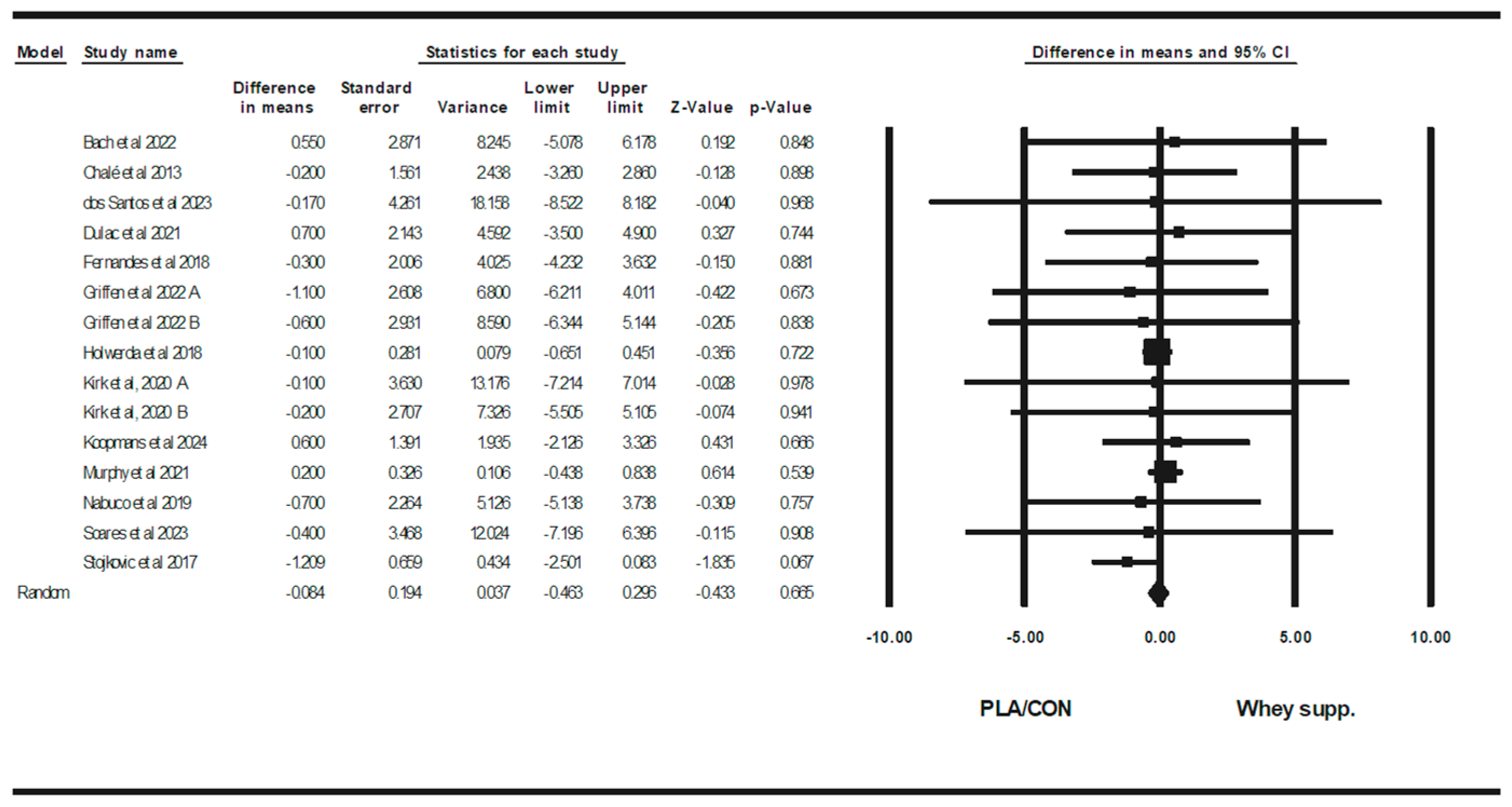
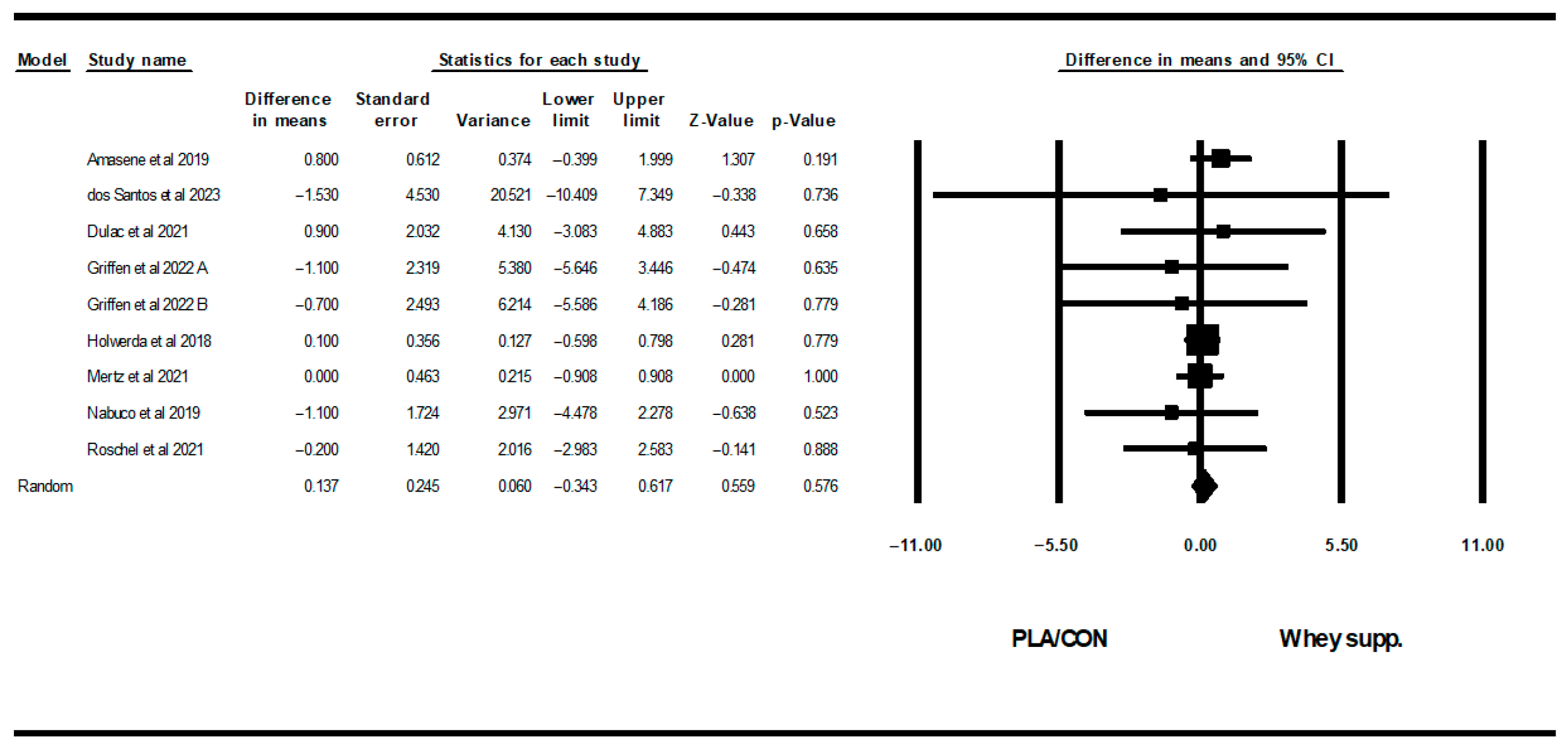
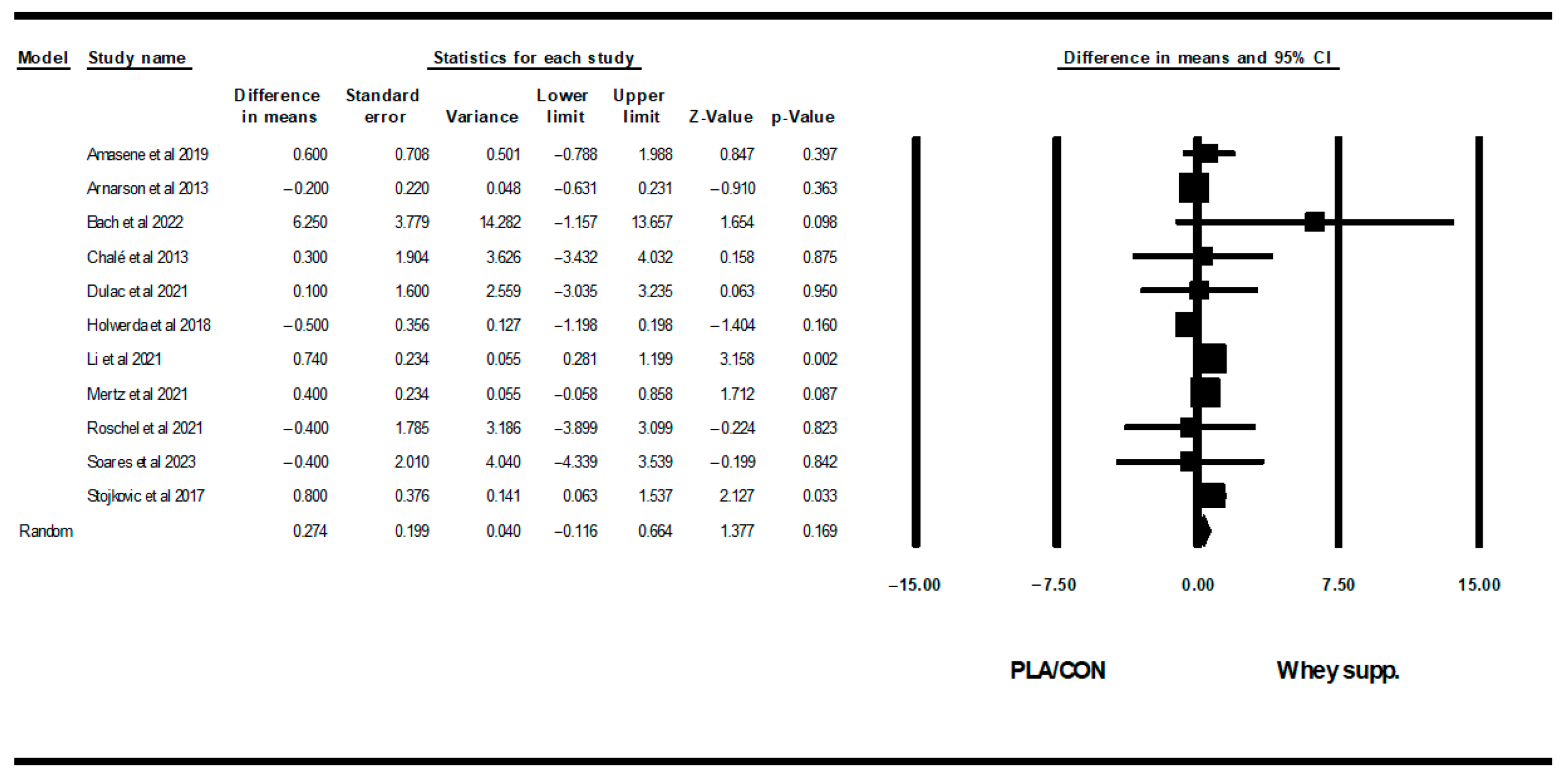
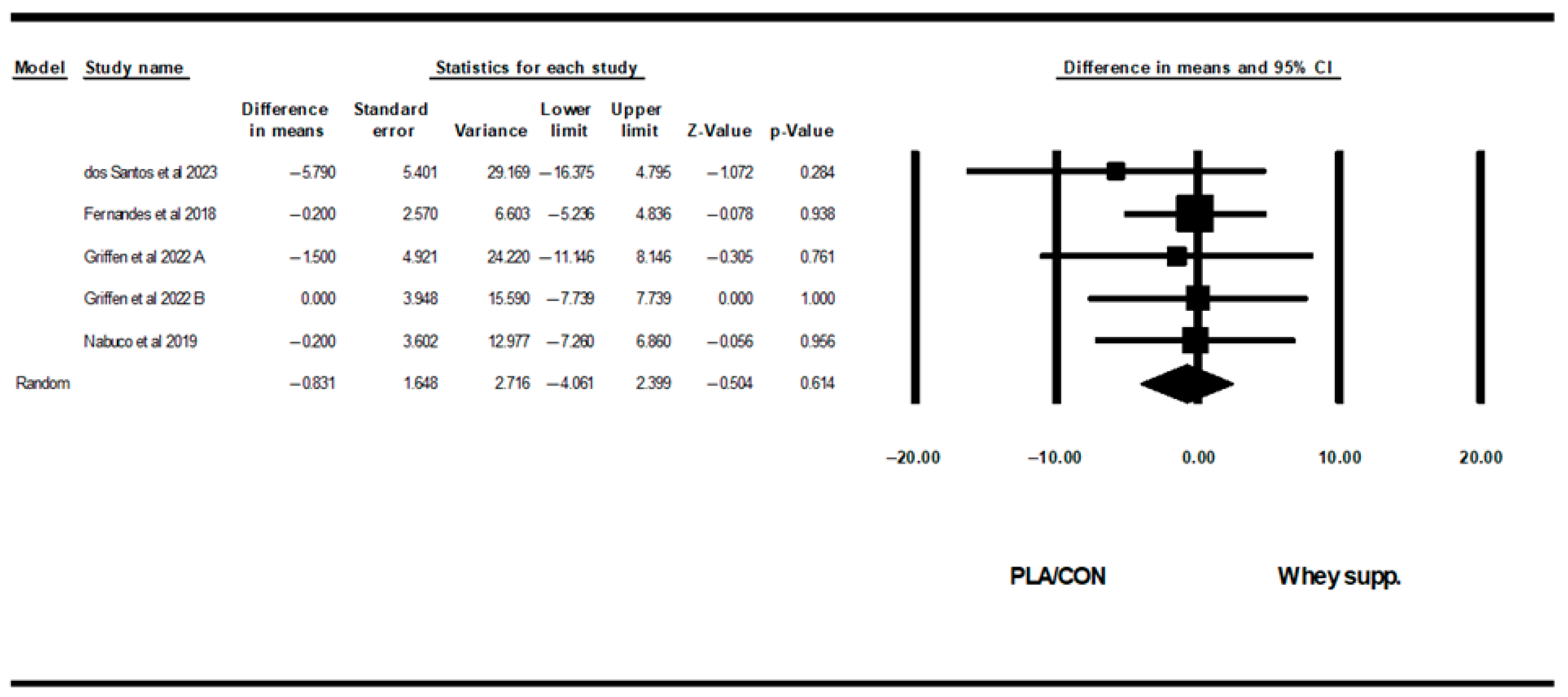

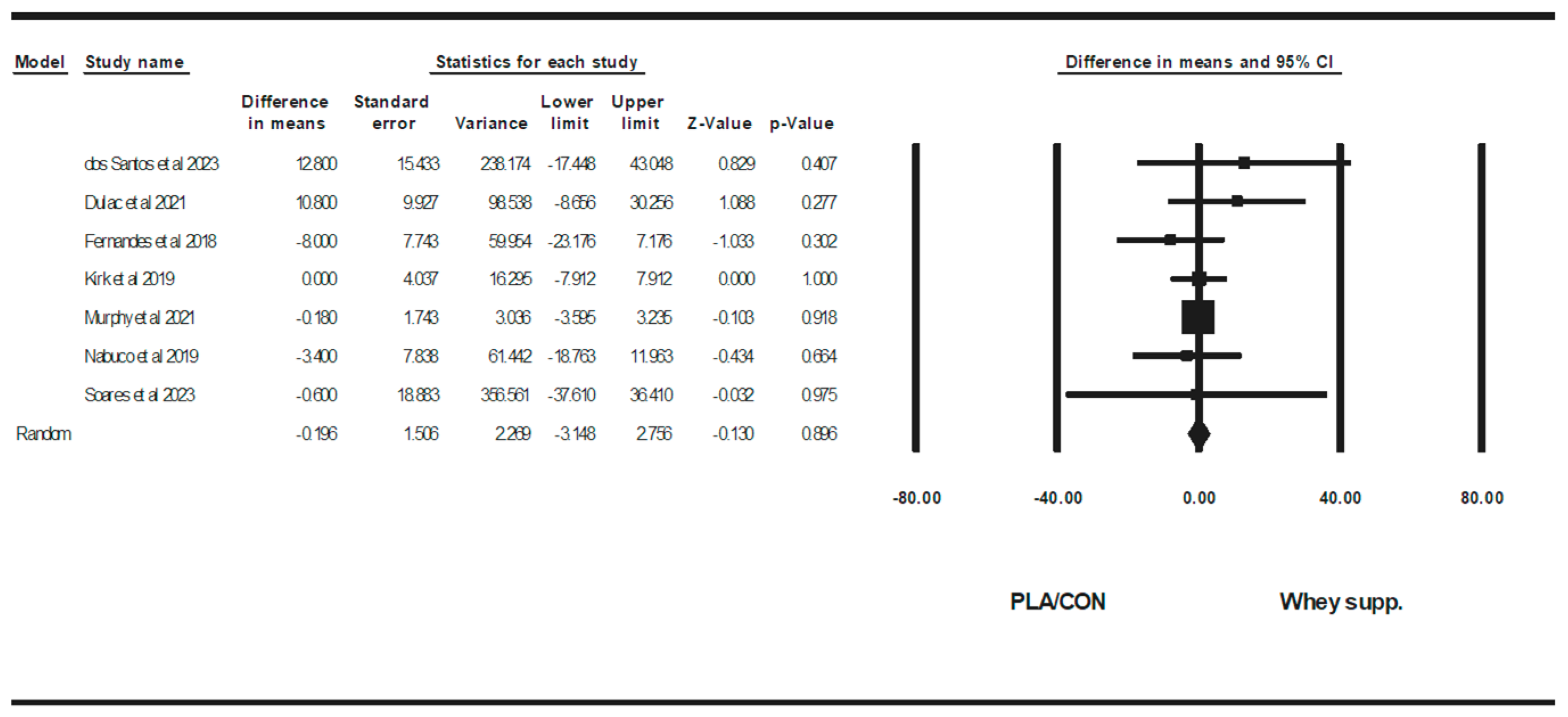

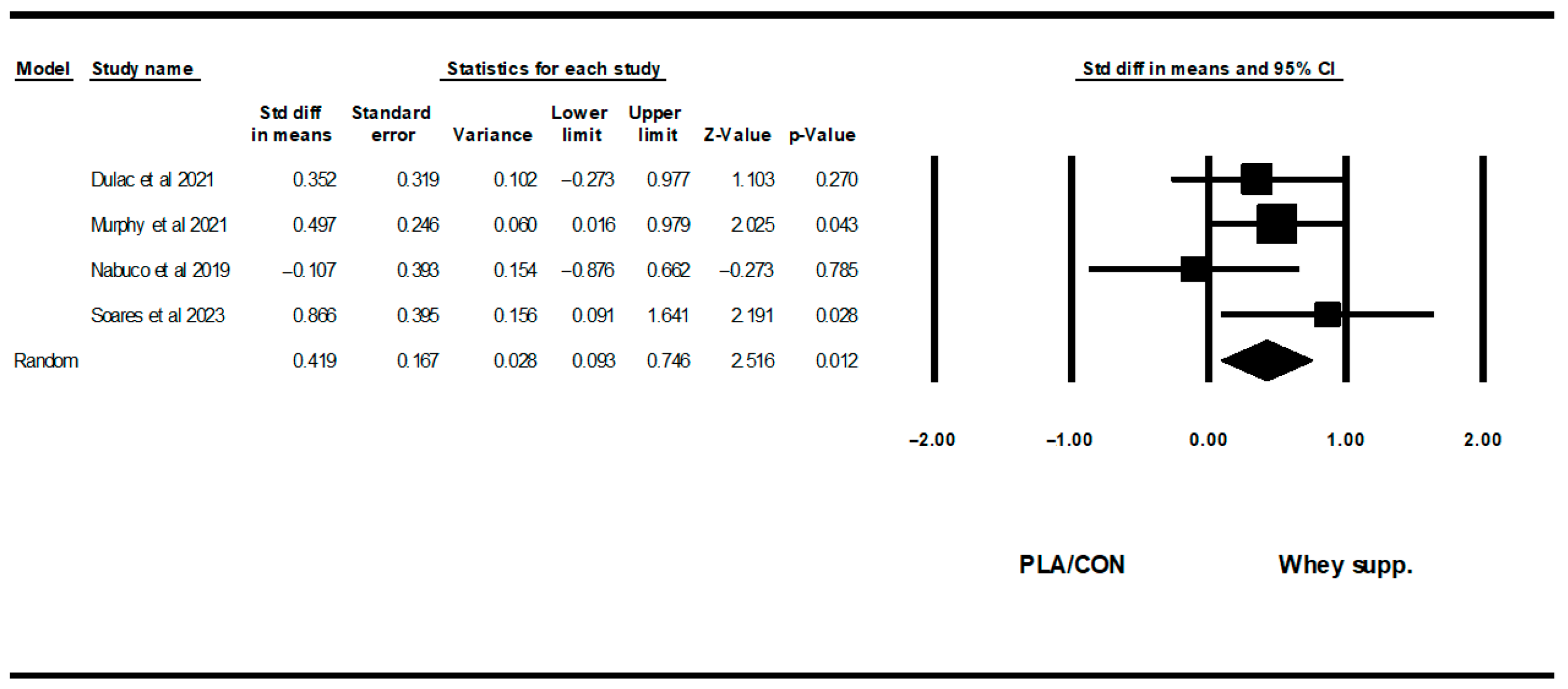
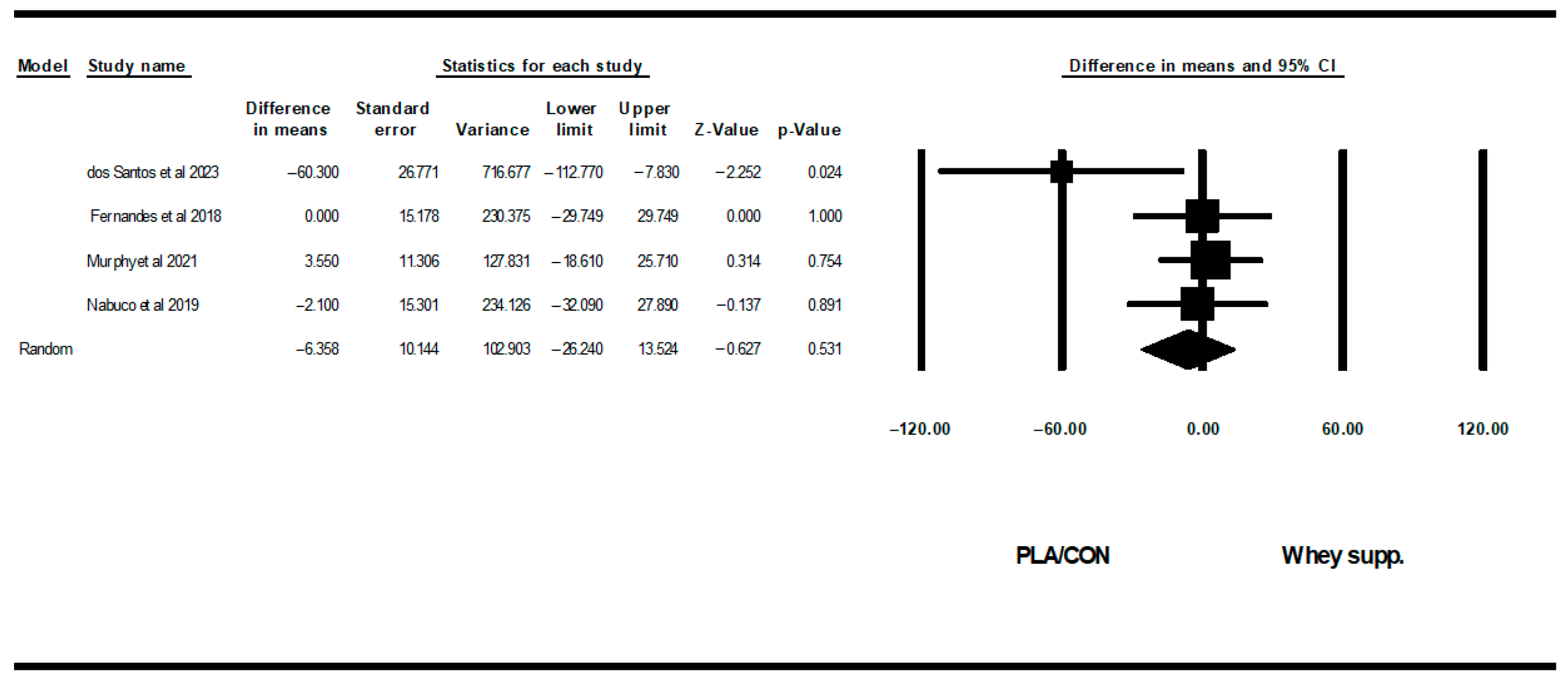




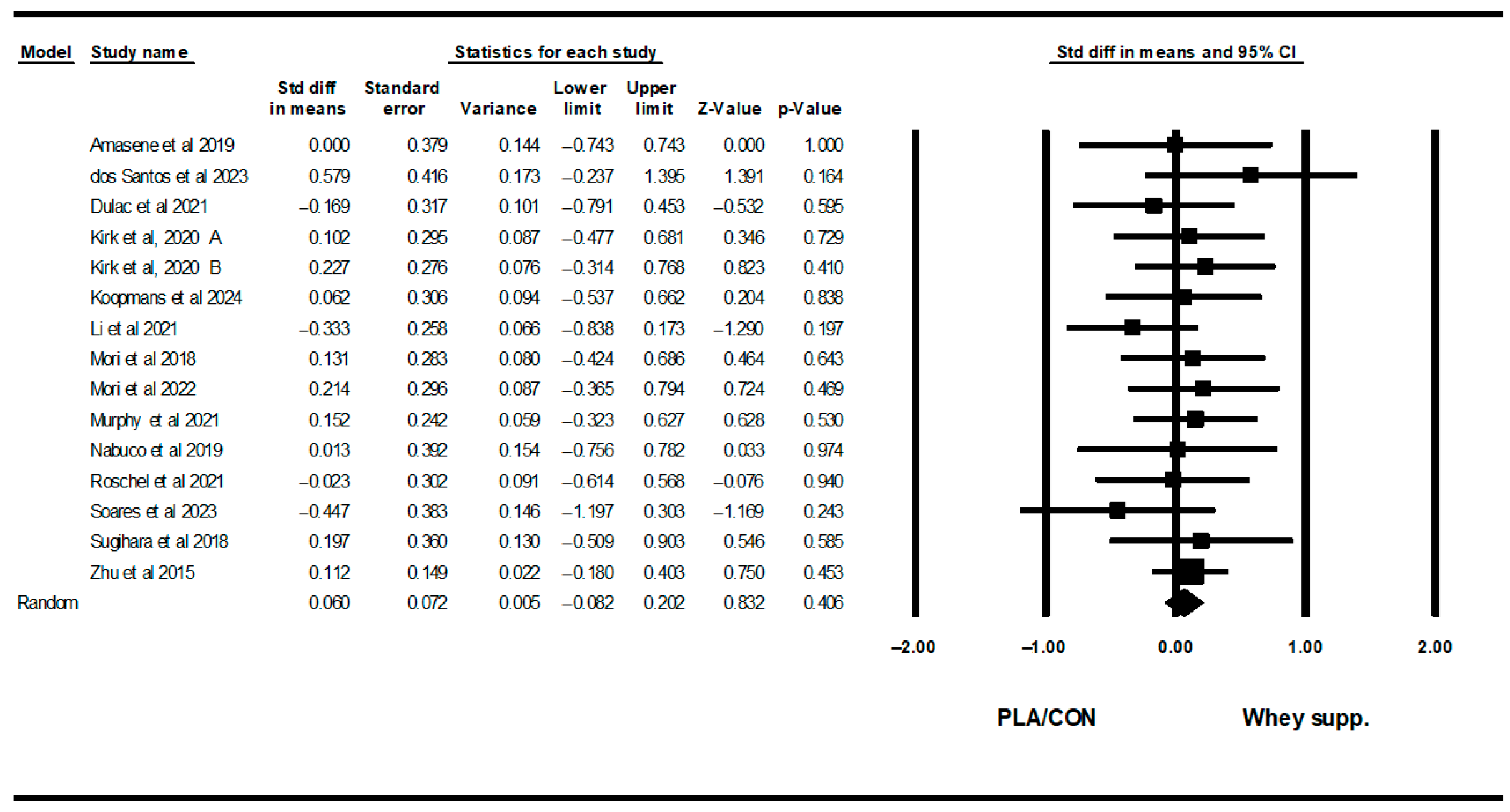
| Source, Year | Participants Characteristics | Intervention Characteristics | Intervention Characteristics | |||||
|---|---|---|---|---|---|---|---|---|
| Sample Size (Sex) | Health Status | Age (Years) | BMI (kg/m2) | Design | Duration | Type | ||
| Amasene et al., 2019 [48] | 28 (F and M) | Sarcopenia | WP + RT: 82.9 ± 5.59 PLA + RT: 81.7 ± 6.45 | WP + RT: 27.4 ± 3.50 PLA + RT: 30.8 ± 6.53 | RCT | 12-wk | WP + Leucine | LBM, BFP, WHR, ST (Handgrip) |
| Arnarson et al., 2013 [49] | 141 (F and M) | Apparently healthy | WP + RT: 73.3 ± 6.0 PLA + RT: 74.6 ± 5.8 | WP + RT: 28.1 ± 4.4 PLA + RT: 29.4 ± 4.8 | RCT | 12-wk | WP | LBM, ST (Quadriceps—isometric) |
| Bach et al., 2022 [50] | 31 (F and M) | Healthy | WP + RT: 66.9 ± 4.3 PLA + RT: 65.8 ± 5.0 | WP + RT: 26.3 ± 2.2 PLA + RT: 25.4 ± 2.0 | RCT | 12-wk | WP | LBM, FM, ST (Peak torque—knee extension) |
| Chalé et al., 2013 [51] | 80 (F and M) | Mobility-Limited | WP + RT: 78.0 ± 4.0 PLA + RT: 77.3 ± 3.9 | WP + RT: 27.0 ± 3.2 PLA + RT: 26.9 ± 3.1 | RCT | 24-wk | WP | LBM, FM, ST (1-RM, leg press) |
| Dos santos et al., 2023 [63] | 25 (F and M) | Chronic Heart failure | WP: 64.0 ± 4.9 PLA: 65.66 ± 17.2 | WP: 28.6 ± 4.6 PLA: 26.8 ± 3.5 | RCT | 12-wk | WP | FBG, FM, BFP, WC, ST (Handgrip), TCH, TG, HDL, LDL |
| Dulac et al., 2021 [52] | 40 (M) | Healthy | 69 ± 7 | WP + RT: 26.7 ± 3.0 PLA + RT: 25.4 ± 3.4 | RCT | 12-wk | WP | FBG, Insulin, HOMA-IR, BFP, FM, LBM, ST (Handgrip, isometric—knee extension) |
| Fernandes et al., 2018 [53] | 32 (F) | Physically independent | WP + RT: 67.3 ± 4.1 PLA + RT: 67.8 ± 4.0 | WP + RT: 25.9 ± 2.7 PLA + RT: 25.4 ± 2.6 | RCT | 12-wk | WP | FBG, FM, WC, WHR, TCH, TG, HDL, LDL |
| Griffen et al., 2022 [70] | 36 (M) | Healthy | WP + RT: 68.0 ± 3.0 PLA + RT: 67.0 ± 3.0 WP: 66.0 ± 6.0 PLA: 67.0 ± 6.0 | WP + RT: 26.6 ± 2.4 PLA + RT: 25.1 ± 2.7 WP: 25.0 ± 1.8 PLA: 25.1 ± 3.0 | RCT | 12-wk | WP + Leucine | Insulin, FM, BFP, WHR, WC, ST (1-RM, leg press) |
| HaB et al., 2022 [54] | 40 (F and M) | Healthy | WP + RT: 71.5 ± 4.6 RT: 69.9 ± 4.5 | WP + RT: 28.2 ± 2.3 RT: 26.9 ± 2.7 | RCT | 8-wk | WP + Leucine | WHR, ST (isometric—Knee extension) |
| Holwerda et al., 2018 [55] | 41 (M) | Healthy | WP + RT: 69 ± 4.58 PLA + RT: 71 ± 4.47 | WP + RT: 25.5 ± 2.74 PLA + RT: 25.1 ± 2.21 | RCT | 12-wk | WP + Leucine | LBM, FM, BFP, ST (1-RM—leg press) |
| Kirk et al., 2019 [61] | 46 (F and M) | Healthy | WP + RT: 69 ± 6 RT: 66 ± 4 | WP + RT: 27.4 ± 4.9 RT: 28.1 ± 7.4 | RCT | 16-wk | WP + Leucine | FBG, ST (1-RM—Leg press, chest press) |
| Kirk et al., 2020 [71] | 100 (F and M) | Healthy | WP + RT: 69 ± 6 WP: 72 ± 6 CON: 68 ± 6 RT: 66 ± 4 | WP + RT: 27.4 ± 4.9 WP: 27.1 ± 4.1 CON: 26.2 ± 4.5 RT: 28.1 ± 7.4 | RCT | 16-wk | WP + Leucine | FM, ST (Handgrip, maximum voluntary contraction—leg extension) |
| Kirk et al., 2021 [36] | 73 (F and M) | Healthy | WP + RT: 68.59 ± 5.7 WP: 71.83 ± 6.5 CON: 68.16 ± 5.85 RT: 66.63 ± 3.92 | 27.06 ± 5.18 | RCT | 16-wk | WP + Leucine | TCH, HDL, LDL |
| Koopmans et al., 2024 [64] | 43 (M) | Healthy | WP: 70.0 ± 5.0 PLA: 68.0 ± 5.0 | WP: 24.4 ± 2.3 PLA: 23.8 ± 2.7 | RCT | 11-wk | WP | FM, ST (Handgrip) |
| Li et al., 2021 [65] | 61 (F and M) | Healthy | WP: 71 ± 4 CON: 71 ± 4 | WP: 21.8 ± 2.0 CON: 20.8 ± 2.2 | RCT | 24-wk | WP + Leucine | LBM, ST (Handgrip) |
| Mertz et al., 2021 [66] | 78 (F and M) | Healthy | WP: 70.3 ± 4.3 PLA: 69.6 ± 3.9 | WP: 25.2 ± 3.6 PLA: 26.0 ± 3.9 | RCT | 1 year | WP + Sucrose | LBM, BFP, ST (Peak torque—knee extension) |
| Mori et al., 2018 [56] | 50 (F) | Healthy | WP + RT: 70.6 ± 4.2 RT: 70.6 ± 4.2 | WP + RT: 22.1 ± 2.1 RT: 22.9 ± 2.9 | RCT | 24-wk | WP + Leucine | ST (Handgrip, knee extension) |
| Mori et al., 2022 [57] | 46 (F and M) | Sarcopenia | WP + RT: 77.7 ± 3.3 RT: 77.6 ± 5.2 | WP + RT: 20.3 ± 2.4 RT: 20.3 ± 2.9 | RCT | 24-wk | WP + Leucine | ST (Handgrip, knee extension) |
| Murphy et al., 2021 [67] | 69 (F and M) | Low muscle mass | WP: 70 ± 5 PLA: 73 ± 7 | WP: 24.8 ± 3.4 PLA: 25.4 ± 2.8 | RCT | 24-wk | WP + Leucine | FBG, Insulin, HOMA-IR, FM, ST (Handgrip, Isokinetic knee extension), TG, TCH, HDL, LDL |
| Nabuco et al., 2019 [58] | 26 (F) | Sarcopenic obesity | WP + RT: 68.0 ± 4.2 PLA + RT: 70.1 ± 3.9 | WP + RT: 26.4 ± 3.0 PLA + RT: 27.4 ± 3.0 | RCT | 12-wk | WP | FBG, Insulin, HOMA-IR, FM, BFP, WC, WHR, ST (1-RM—Knee extension, chest press), TG, TCH, LDL, HDL |
| Roschel et al., 2021 [60] | 44 (F) | Pre-frail, frailty | 72 ± 6 | N R | RCT | 16-wk | WP | LBM, BFP, ST (1-RM—leg press, chest press) |
| Soares et al., 2023 [62] | 28 (M) | T2DM | WP + RT: 68.1 ± 4.5 PLA + RT: 68.9 ± 4.1 | WP + RT: 29.3 ± 2.6 PLA + RT: 26.8 ± 3.8 | RCT | 12-wk | WP | FBG, Insulin, HOMA-IR, LBM, FM, ST (Handgrip) |
| Stojkovic et al., 2017 [68] | 84 (F) | Postmenopausal women | WP: 68.9 ± 5.54 PLA: 69.3 ± 6.10 | WP: 26.0 ± 3.69 PLA: 25.8 ± 4.06 | RCT | 18 months | WP | LBM, FM |
| Sugihara et al., 2018 [59] | 31 (F) | Physically independent | WP + RT: 67.4 ± 4.1 PAL + RT: 67.8 ± 4.1 | WP + RT: 25.6 ± 2.4 PLA + RT: 25.4 ± 2.6 | RCT | 12-wk | WP + Leucine | ST (1-RM—knee extension, chest press) |
| Zhu et al., 2015 [69] | 181 (F) | Postmenopausal women | WP: 74.2 ± 2.8 PLA: 74.3 ± 2.6 | WP: 26.1 ± 3.8 PLA: 27.2 ± 4.0 | RCT | 2 years | WP | ST (Handgrip, knee extension) |
Disclaimer/Publisher’s Note: The statements, opinions and data contained in all publications are solely those of the individual author(s) and contributor(s) and not of MDPI and/or the editor(s). MDPI and/or the editor(s) disclaim responsibility for any injury to people or property resulting from any ideas, methods, instructions or products referred to in the content. |
© 2025 by the authors. Licensee MDPI, Basel, Switzerland. This article is an open access article distributed under the terms and conditions of the Creative Commons Attribution (CC BY) license (https://creativecommons.org/licenses/by/4.0/).
Share and Cite
Khalafi, M.; Fatolahi, S.; Jafari, R.; Rosenkranz, S.K.; Symonds, M.E.; Abbaszadeh Bidgoli, Z.; Fernandez, M.L.; Dinizadeh, F.; Batrakoulis, A. Effects of Whey Protein Supplementation on Body Composition, Muscular Strength, and Cardiometabolic Health in Older Adults: A Systematic Review with Pairwise Meta-Analysis. Healthcare 2025, 13, 2814. https://doi.org/10.3390/healthcare13212814
Khalafi M, Fatolahi S, Jafari R, Rosenkranz SK, Symonds ME, Abbaszadeh Bidgoli Z, Fernandez ML, Dinizadeh F, Batrakoulis A. Effects of Whey Protein Supplementation on Body Composition, Muscular Strength, and Cardiometabolic Health in Older Adults: A Systematic Review with Pairwise Meta-Analysis. Healthcare. 2025; 13(21):2814. https://doi.org/10.3390/healthcare13212814
Chicago/Turabian StyleKhalafi, Mousa, Saeid Fatolahi, Reihaneh Jafari, Sara K. Rosenkranz, Michael E. Symonds, Zeinab Abbaszadeh Bidgoli, Maria Luz Fernandez, Farnaz Dinizadeh, and Alexios Batrakoulis. 2025. "Effects of Whey Protein Supplementation on Body Composition, Muscular Strength, and Cardiometabolic Health in Older Adults: A Systematic Review with Pairwise Meta-Analysis" Healthcare 13, no. 21: 2814. https://doi.org/10.3390/healthcare13212814
APA StyleKhalafi, M., Fatolahi, S., Jafari, R., Rosenkranz, S. K., Symonds, M. E., Abbaszadeh Bidgoli, Z., Fernandez, M. L., Dinizadeh, F., & Batrakoulis, A. (2025). Effects of Whey Protein Supplementation on Body Composition, Muscular Strength, and Cardiometabolic Health in Older Adults: A Systematic Review with Pairwise Meta-Analysis. Healthcare, 13(21), 2814. https://doi.org/10.3390/healthcare13212814











